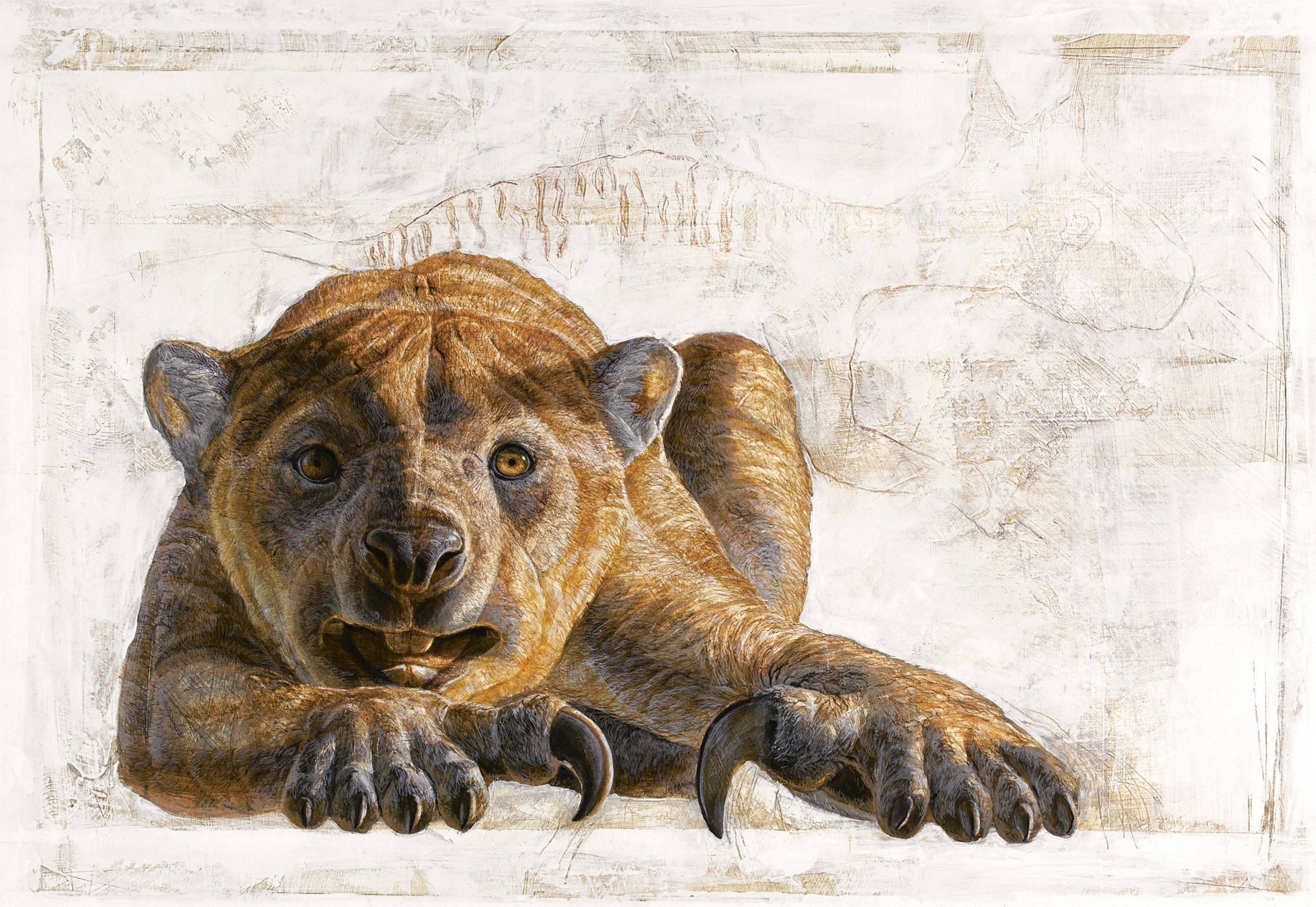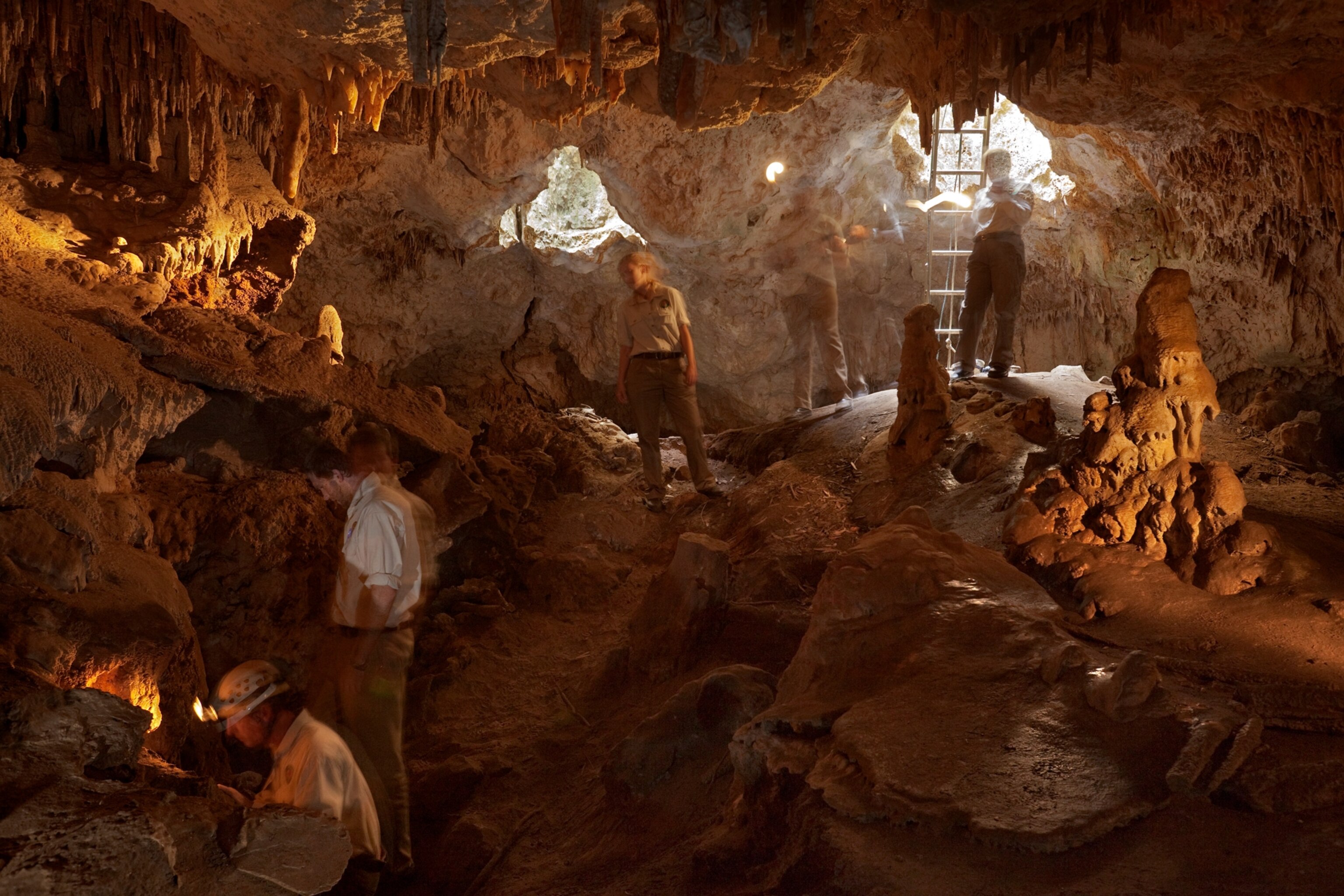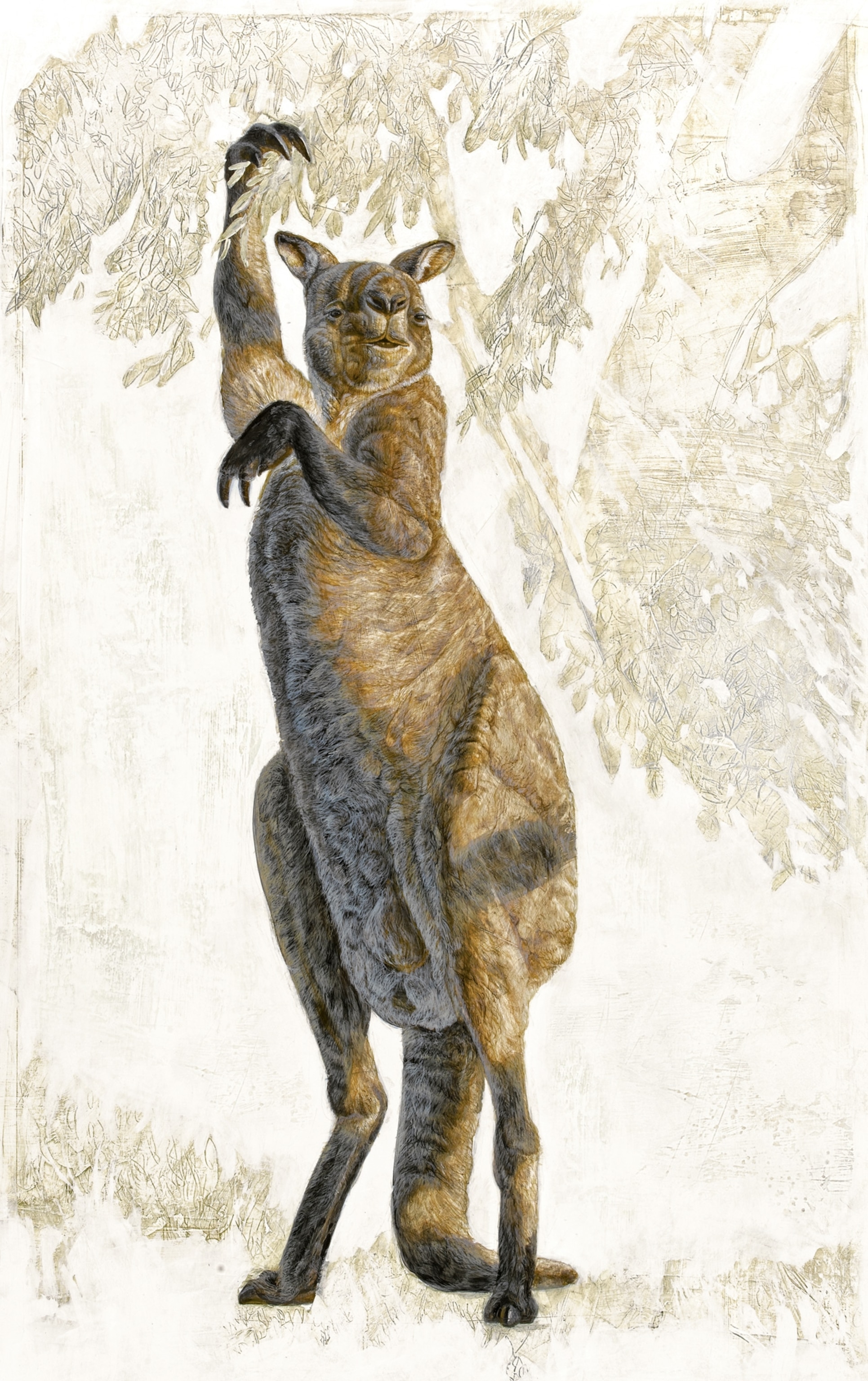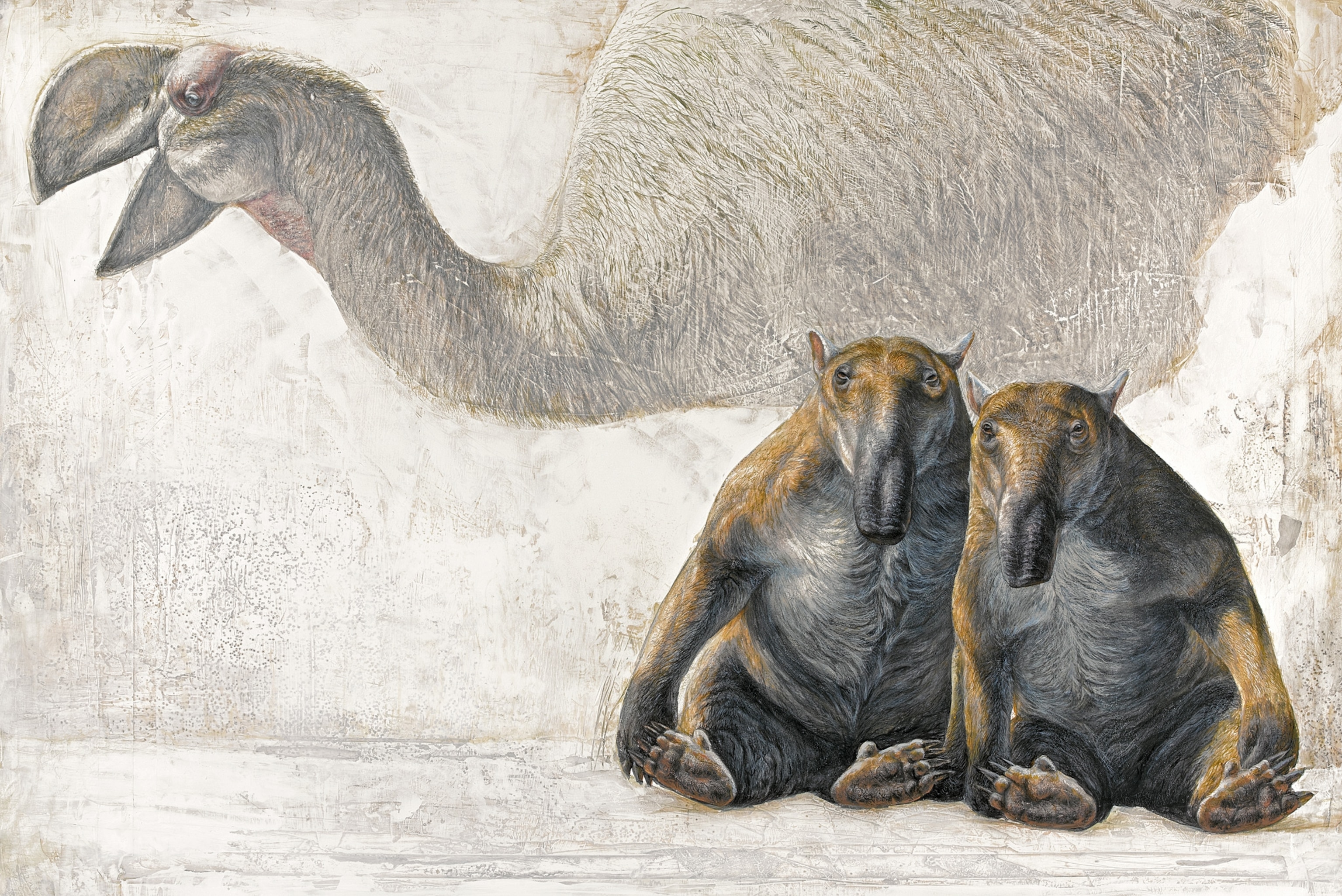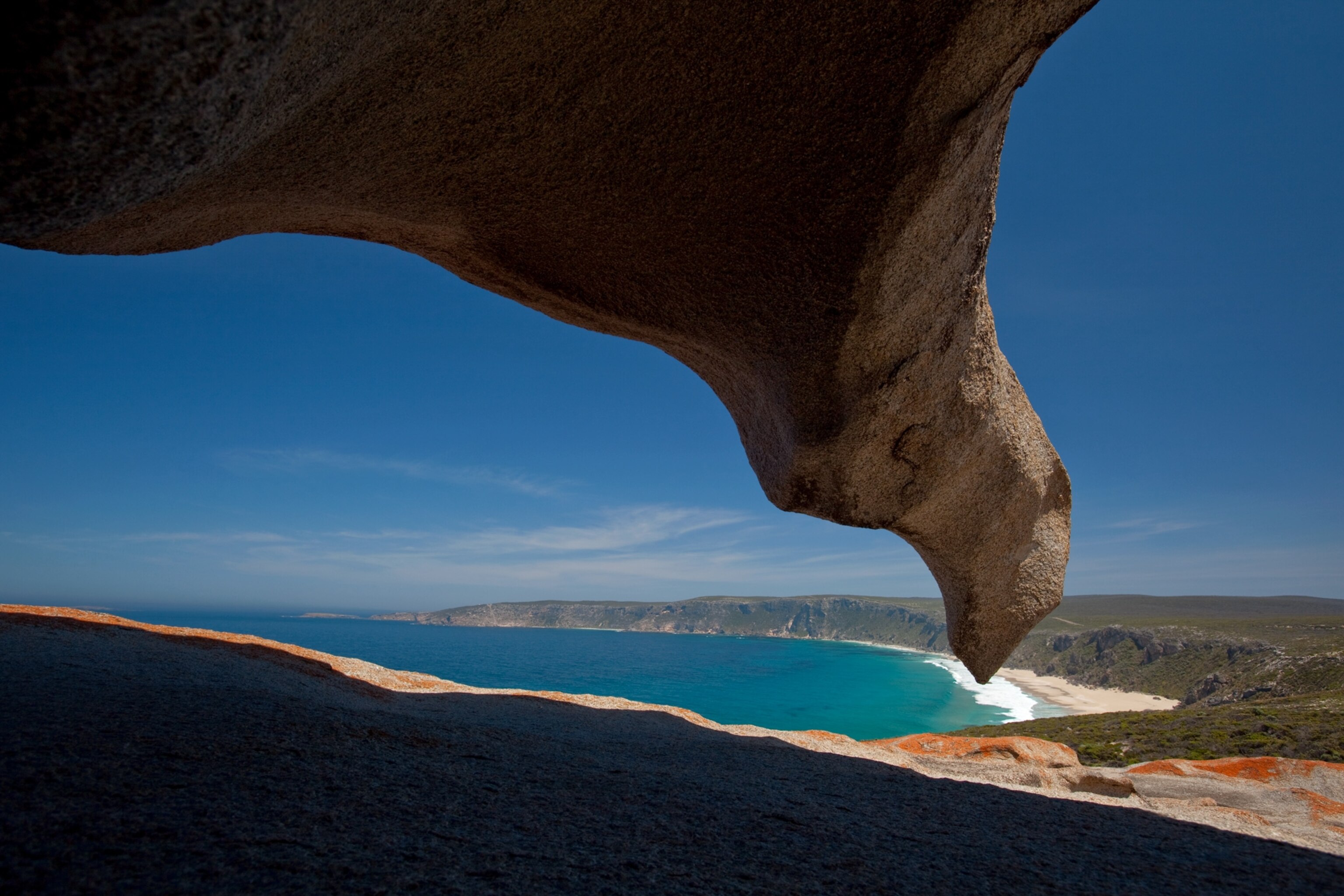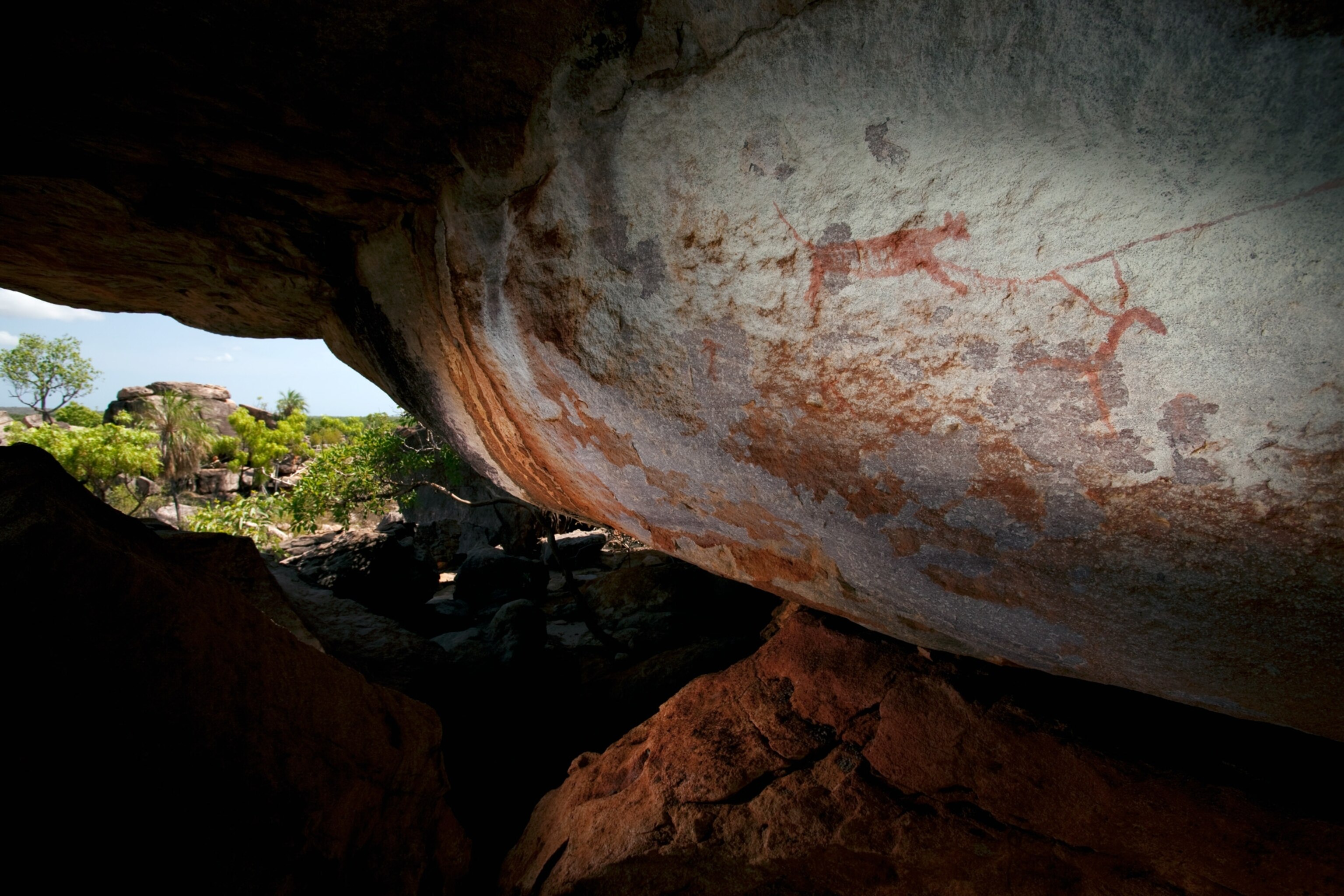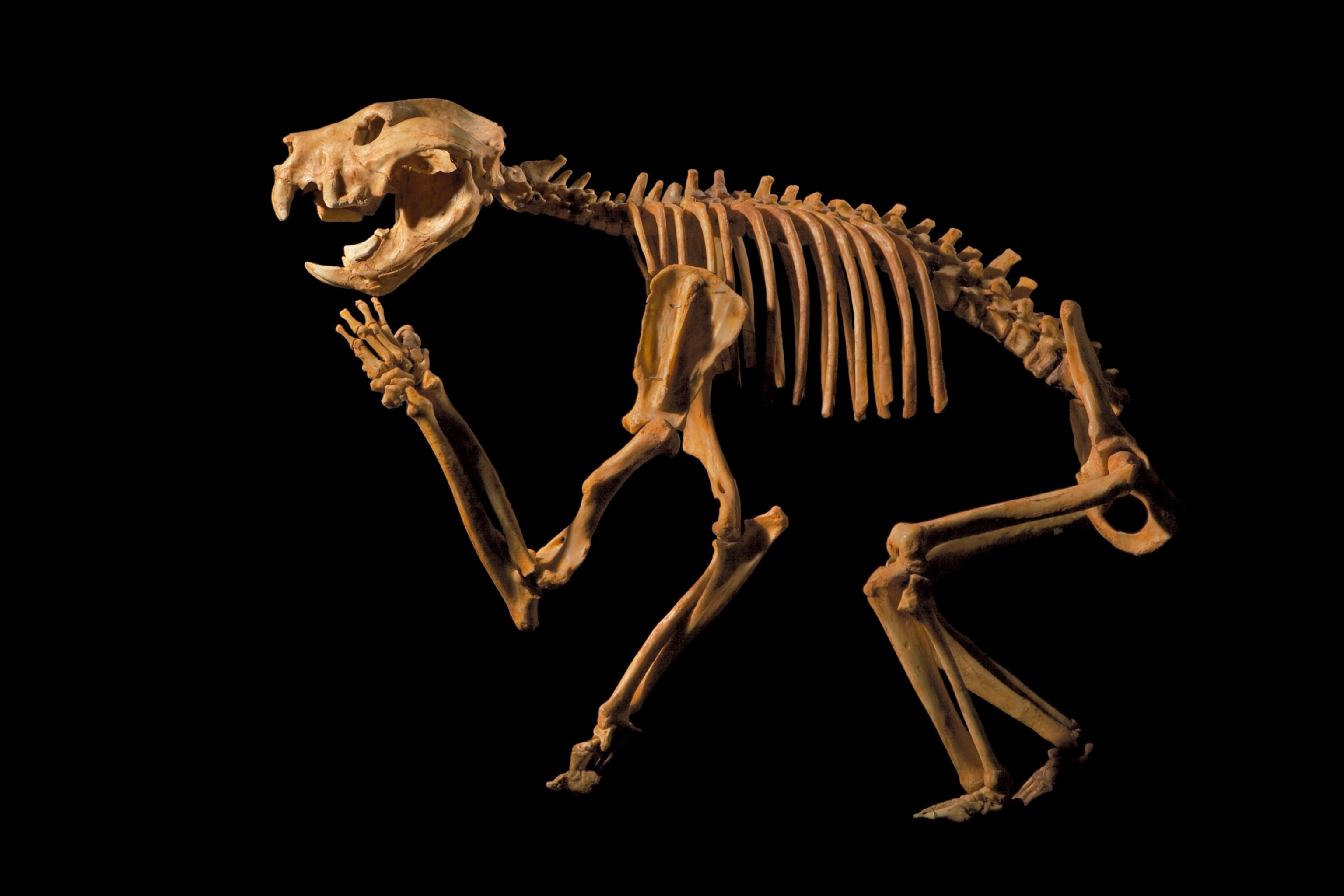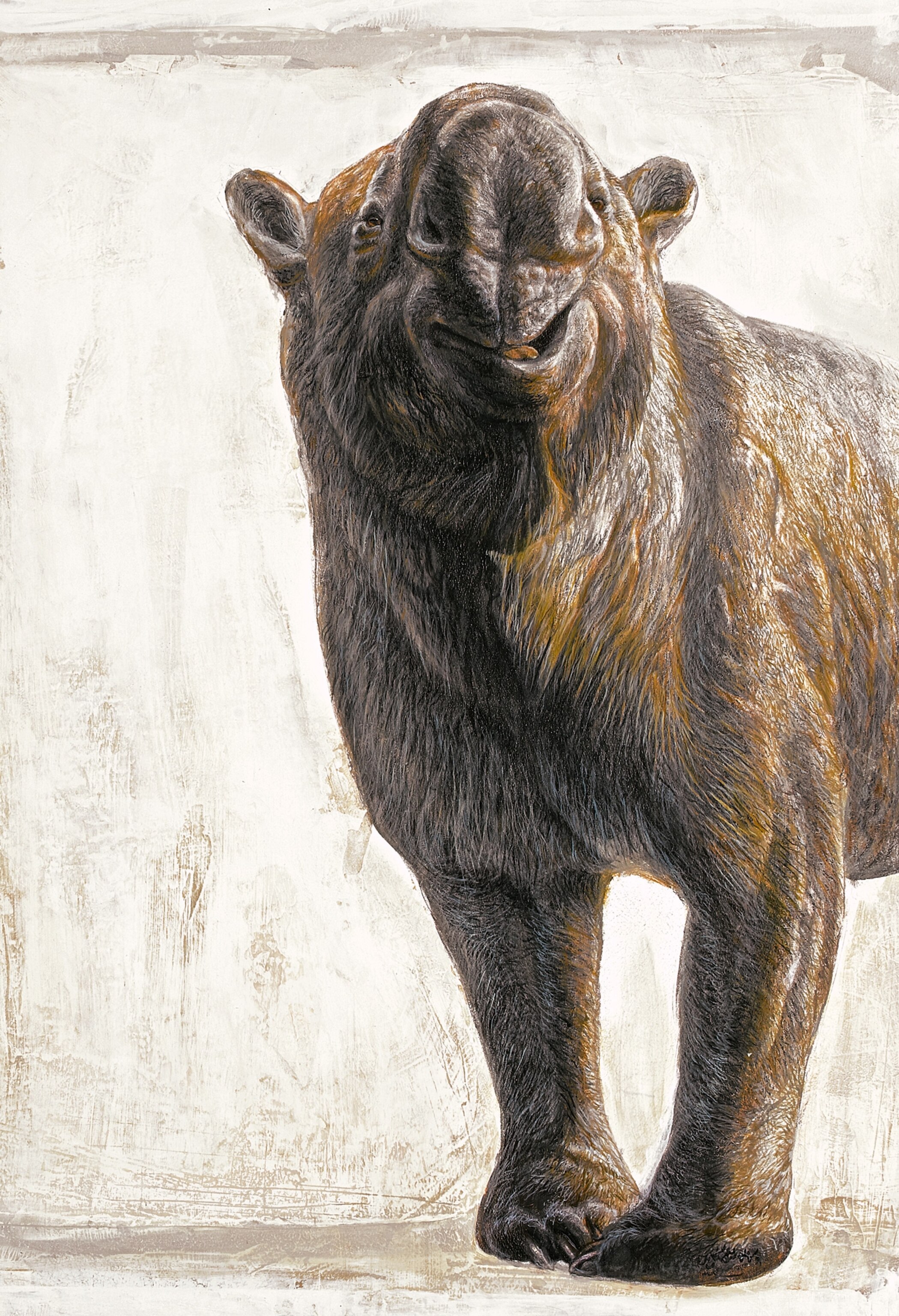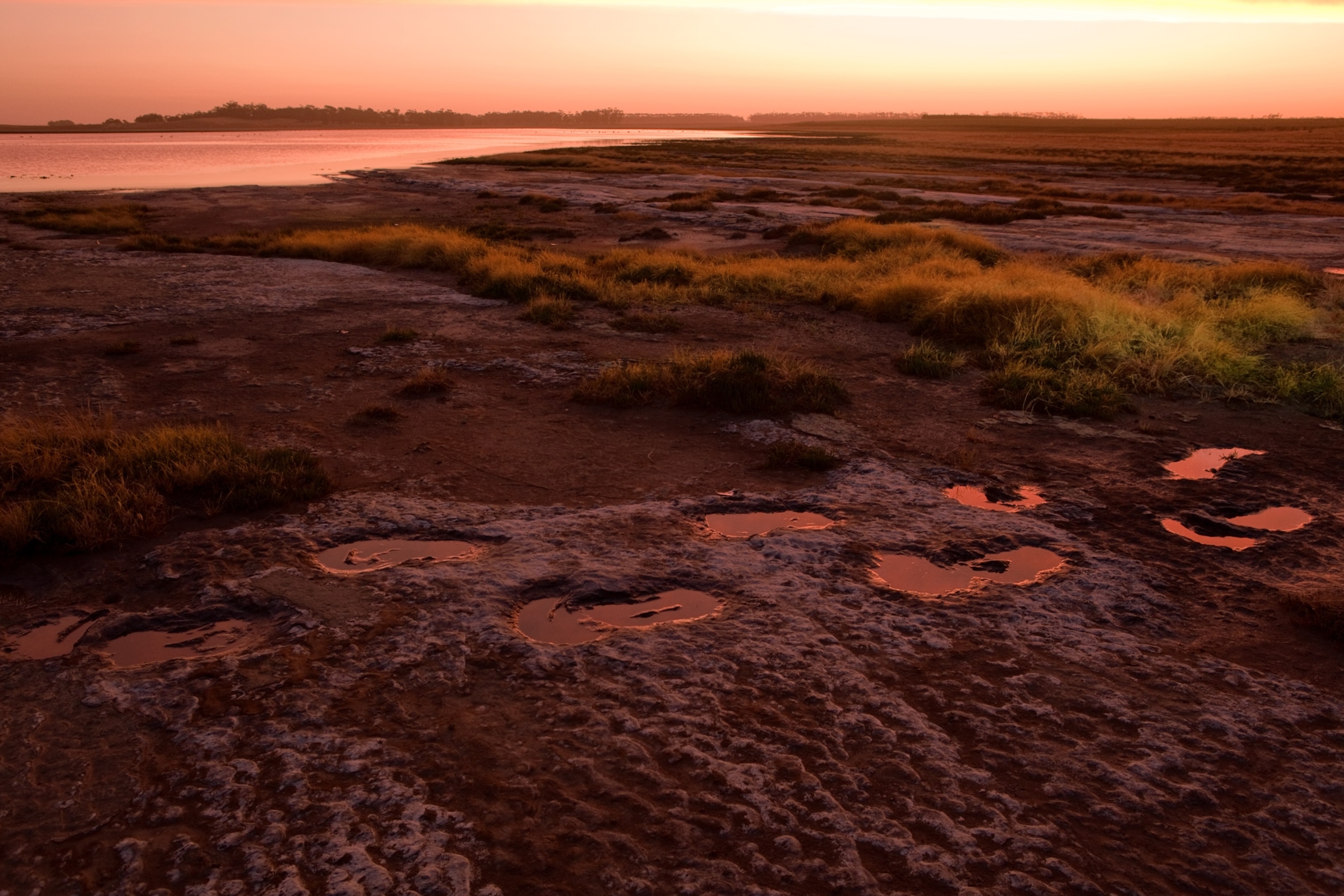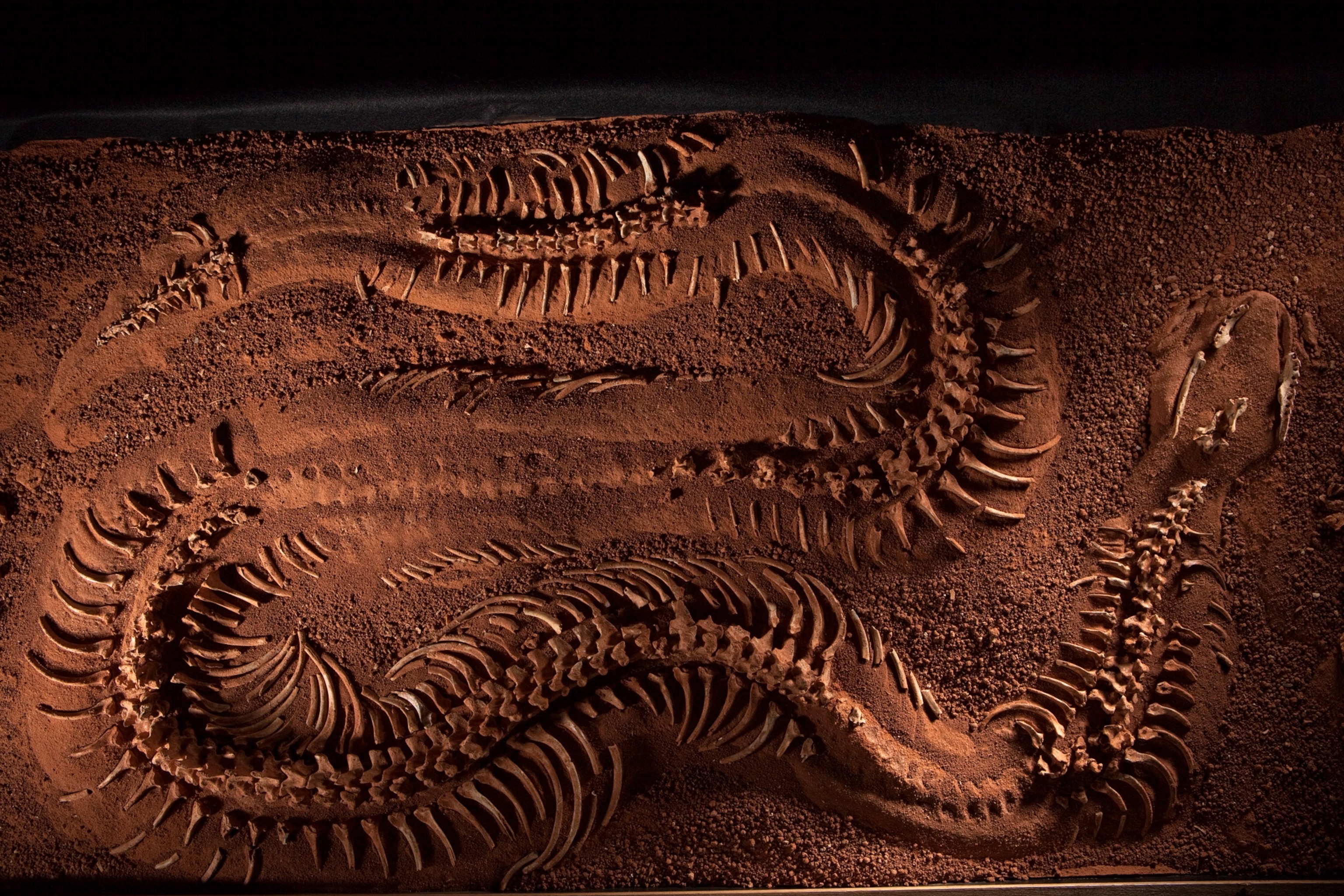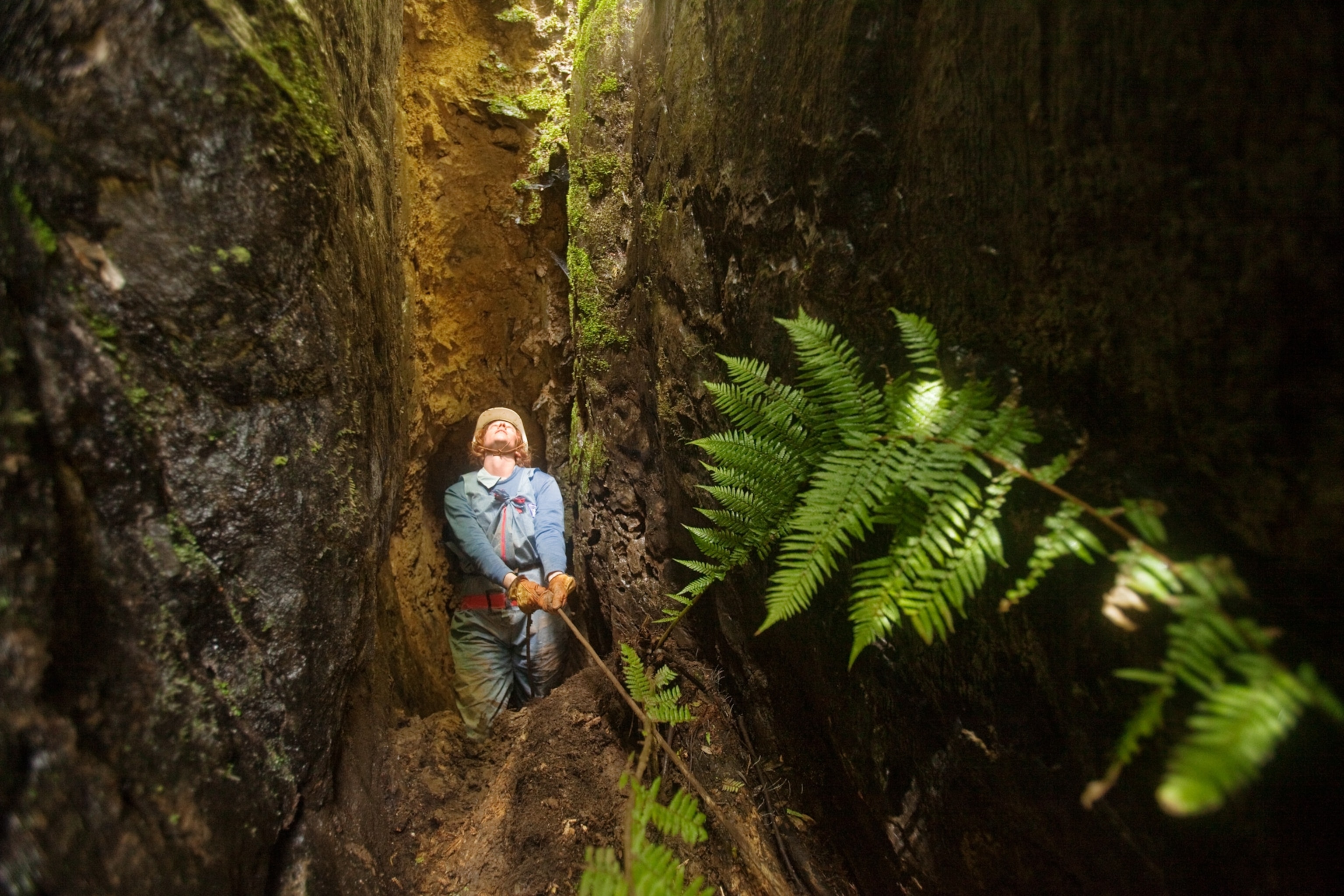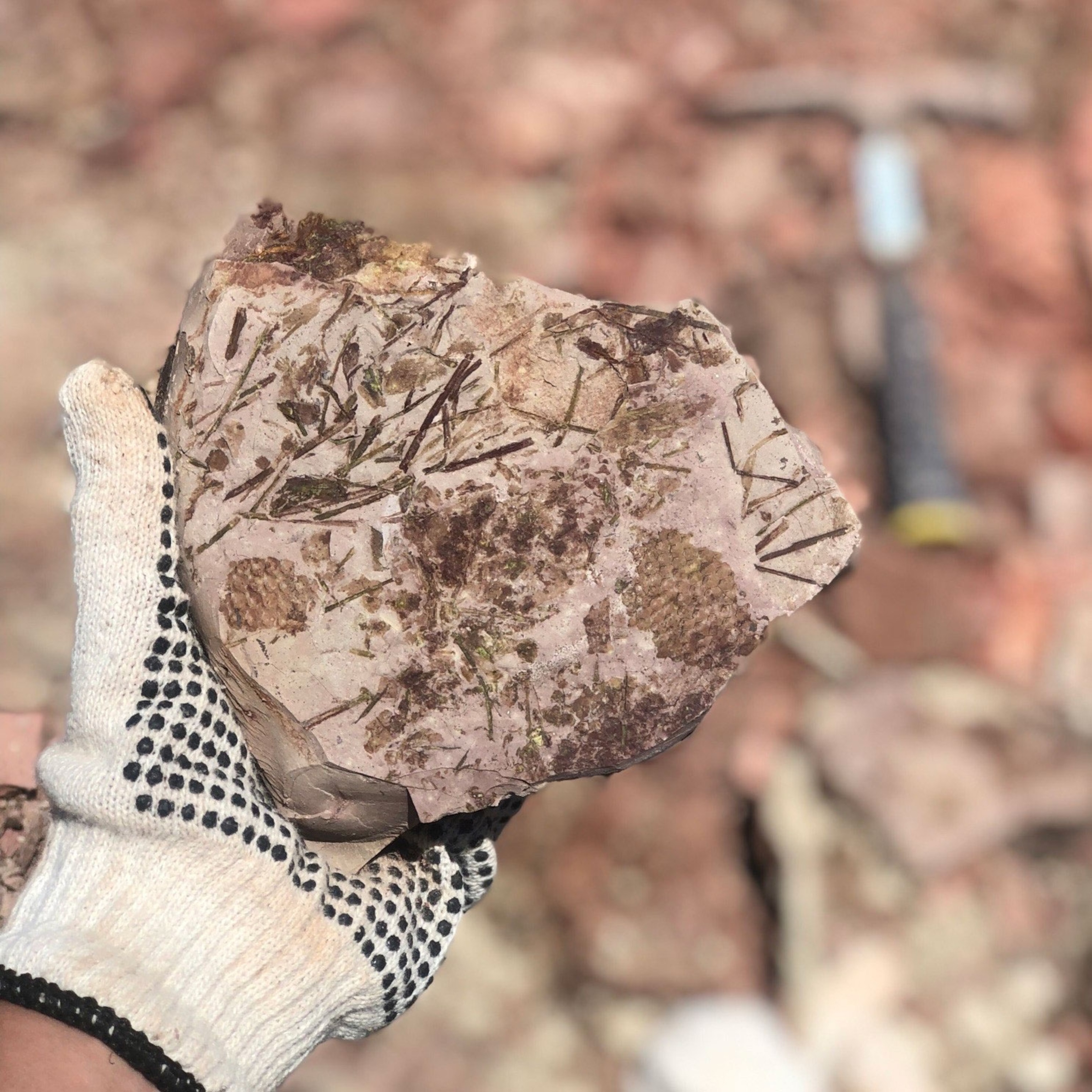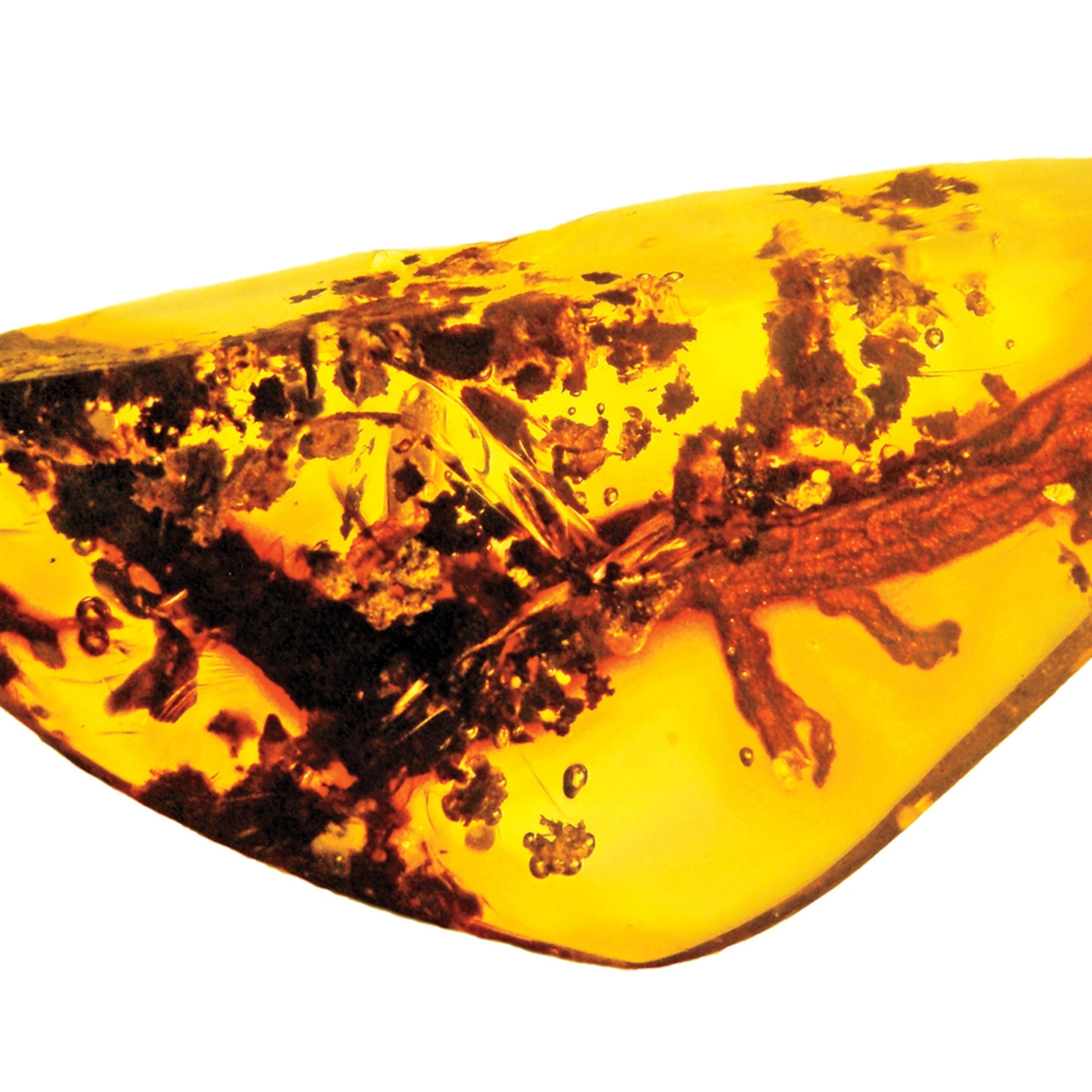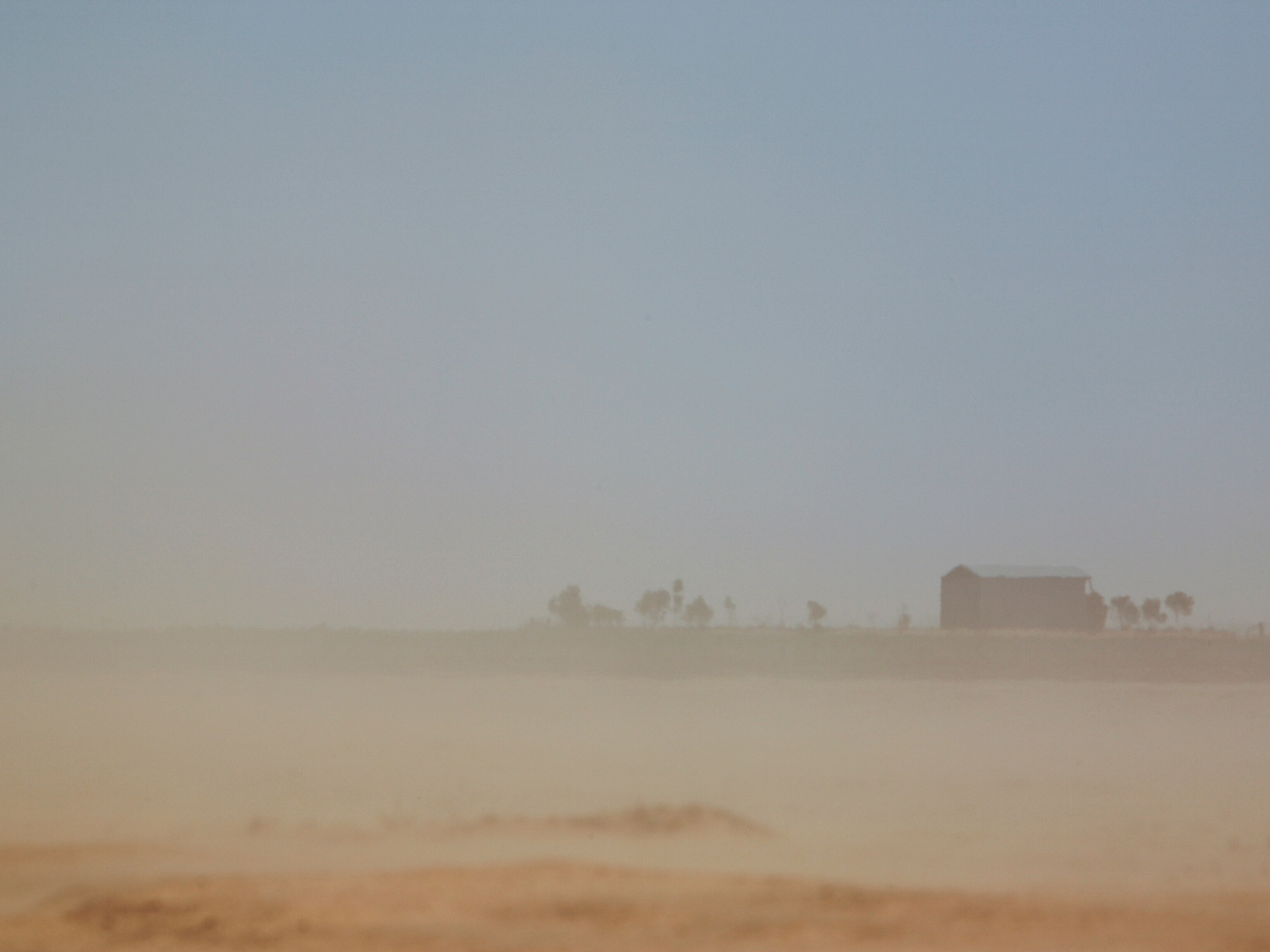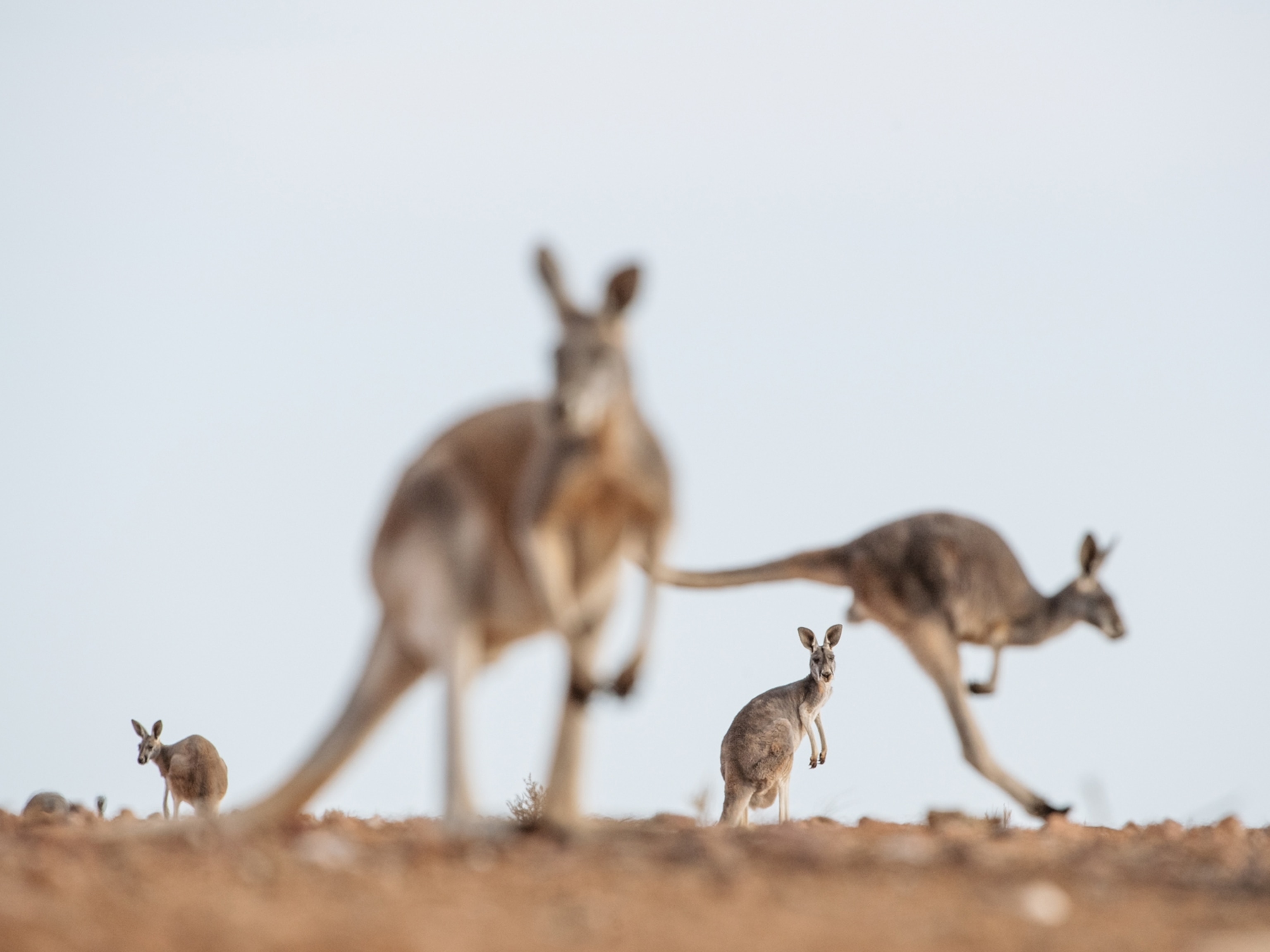Australia's Lost Giants
Seven-foot-tall kangaroos, rhino-size browsers, enormous flightless birds, and a predator that could kill them all: Such were the megafauna that once dominated Australia. Then humans arrived, and most of the giant animals vanished. Did the Ice Age finally catch up with them? Or did humans hunt megafauna to extinction?
You will find the Naracoorte Caves in the pastoral wine country of South Australia, four hours from Adelaide on lonely roads heading toward what the Aussies call the Southern Ocean. The grapevines thrive in red soil that sits like a layer of icing on porous limestone. It's lovely country, but it can be treacherous. The ground is pocked with holes, many no wider than a café table, known as pitfall traps. They're deep. They plunge into the blackest of caverns. Pitfall traps have gobbled up many a kangaroo bounding through the night.
One day in 1969 a fledgling fossil hunter named Rod Wells came to Naracoorte to explore what was then known as Victoria Cave. It was an old tourist attraction, with steps and handrails and electric lights. But Wells and half a dozen colleagues ventured beyond the tourist section, clawing through dark, narrow passages. When they felt a suggestive breeze wafting from a pile of loose rubble, they knew there was a chamber beyond. Wells and one other slithered into the huge room. Its expansive floor of red soil was littered with strange objects. It took Wells a moment to realize what they were looking at. Bones: lots of bones. Pitfall-trap victims galore.
Victoria Fossil Cave, as the cavern is now known, warehouses the bones of something like 45,000 animals. Some of the oldest bones belonged to creatures far larger and more fearsome than any found today in Australia. They were the ancient Australian megafauna—huge animals that roamed the continent during the Pleistocene epoch.
In boneyards across the continent, scientists have found the fossils of a giant snake; a huge flightless bird; a wombat-like creature the size of a rhinoceros; and a seven-foot-tall kangaroo with a strangely short face. They've found the remains of a tapir-like creature; a hippo-like beast; and a lizard, 20 feet long, that ambushed its prey and swallowed everything down to the last feather.
The Australian megafauna dominated their ecosystems—and then were gone in an extinction spasm that swept away nearly every animal that weighed a hundred pounds or more. What, exactly, killed them off?
Given how much ink has been spilled on the extinction of the dinosaurs, it's a wonder that even more hasn't been devoted to the megafauna of the Pleistocene, creatures that had the dual virtues of being dramatically large and coexistent with humans. Prehistoric humans never threw spears at Tyrannosaurus rex, except in cartoons. Humans, however, really did hunt mammoths and mastodons.
The disappearance of American megafauna—mammoths, camels, giant short-faced bears, giant armadillos, stag moose, glyptodonts, saber-toothed cats, dire wolves, giant ground sloths, and horses, among others—happened relatively soon after the arrival of human beings, about 13,000 years ago. In the 1960s, paleoecologist Paul Martin developed what became known as the blitzkrieg hypothesis. Modern humans, Martin said, created havoc as they spread through the Americas, wielding spears tipped with stone points to annihilate animals that had never faced a technological predator. But the extinction spasm wasn't comprehensive. North America kept its deer, pronghorn, black bears, and a small type of bison; brown bears and newly arrived elk and moose expanded their ranges. South America retained jaguars and llamas.
In Australia the largest indigenous land animals are red kangaroos.
What happened to Australia's large animals is one of the planet's most baffling paleontological mysteries. For years scientists blamed the extinctions on climate change. Indeed, Australia has been drying out for a million years or more, and the megafauna were faced with a continent that became increasingly parched and denuded of vegetation. Australian paleontologist Tim Flannery suggests that humans, who arrived on the continent around 50,000 years ago, used fire to hunt, which led to deforestation and a dramatic disruption of the hydrologic cycle.
Here's what's certain, Flannery says. Something dramatic happened to Australia's dominant land creatures—abruptly (how abruptly is a matter of debate)—somewhere around 46,000 years ago, strikingly soon after the invasion of a tool-wielding, highly intelligent predator.
In 1994 Flannery published a book called The Future Eaters, in which he advanced the antipodal version of Paul Martin's blitzkrieg hypothesis. He put forth an even broader and more ambitious thesis as well: that human beings, in general, are a new kind of animal on the planet, one prone to ruining ecosystems and destroying their own futures.
Flannery's book proved highly controversial. Some viewed it as critical of the Aborigines, who pride themselves on living in harmony with nature. The more basic problem with Flannery's thesis is that there is no direct evidence that human beings killed any of the megafauna—not so much as a single animal. It would be helpful if someone uncovered aDiprotodon skeleton with a spear point embedded in a rib—or perhaps a pile of Thylacoleobones next to the charcoal of a human campfire. Such kill sites have been found in the Americas. But there's no archaeological analog in Australia. As one of Flannery's most prominent critics, Stephen Wroe of the University of New South Wales, puts it, "If this were a murder trial, it wouldn't get past first base. It would be laughed out of court."
Another challenge to the Flannery model of Australian megafauna extinction is more mechanistic: How could people armed with only spears and fire have eradicated so many species? Relatively few people, maybe numbering in just the thousands, would have had to kill a population of animals dispersed in a wide variety of habitats and refuges across an entire continent. Extinction is different: By definition there can be no survivors.
The debate about megafauna pivots to a great degree on the techniques for dating old bones and the sediments in which they are buried. It's all about timing. If scientists can show that the megafauna died out fairly quickly and that this extinction event happened within a few hundred years, or even a couple thousand years, of the arrival of humans, that's a strong case—even if a purely circumstantial one—that the one thing was the direct result of the other. Flannery contends that islands hold another clue to the mystery. Some species of megafauna survived on Tasmania until 40,000 years ago, when falling sea levels allowed humans to finally reach the island, Flannery says. That parallels the situation of mammoths in Siberia and giant sloths in the Americas, which also found island refuges and survived for thousands of years after the broader extinction spasms on the mainland. This line of argument relies on the lack of fossil evidence for a prolonged human-megafauna overlap. If, however, we find evidence that human beings and megafauna lived side by side for many thousands or tens of thousands of years, then the role of humans in the extinctions would become blurry at best. Certainly it would disprove the notion of a rapid-fire, Martin-Flannery-style blitzkrieg.
As it happens, there is one place in the Australian outback where there may be such evidence. But which extinction hypothesis the evidence supports is still in question.
Cuddie Springs is an ephemeral lake in north-central New South Wales. Way back in 1878 a farmer sinking a well turned up megafauna bones at Cuddie. Today the person most vocal about the site, a woman who has spent her career excavating and interpreting its fossils, is Judith Field, an archaeologist at the University of Sydney.
In 1991, working as a graduate student at the site, Field discovered megafauna bones directly adjacent to stone tools—a headline-making find. She says there are two layers showing the association, one about 30,000 years old, the other 35,000 years old. If that dating is accurate, it would mean humans and megafauna coexisted in Australia for something like 20,000 years.
"What Cuddie Springs demonstrates is that you have an extended overlap of humans and megafauna," Field says.
Nonsense, say her critics. They say the fossils have been moved from their original resting places and redeposited in younger sediments. Bert Roberts, a co-author with Flannery of a 2001 paper that argues for some kind of human causation in megafauna extinctions, has examined grains of sand at Cuddie and says he has found very young grains mixed among the supposedly older fossils. That tells him that the stratigraphy is not clear-cut.
"If you don't even know the order of events, it's worthless, a waste of time," Roberts says.
Rainer Grün, another Australian scientist who has dated fossils from the site, backs Roberts, saying Cuddie Springs is a bit disorderly: "This site shows clear signs of disturbance. And if it's disturbed, anything is possible. It's possible that the archaeological artifacts and the megafauna really do go together. I'm not denying that. You just can't make the case for it."
Field vigorously disputes that interpretation and argues that her critics are too wed to a human impact hypothesis for the megafauna extinctions.
Unfortunately, Cuddie Springs was completely flooded and unreachable when I visited Australia to report this story (not that I could have, in any case, refereed the stratigraphic dispute). Field and I decided to drive instead to another famous boneyard in the same general region, a place called Wellington Caves. We drove for five hours from Sydney, across the Blue Mountains through a pastoral country that looks much like the rolling coastal lands of central California. When we pulled into the Wellington Caves parking lot, we found it guarded by a fiberglass Diprotodon.
Diprotodon was most mega of the megafauna, the largest known marsupial ever to tread the Earth. Bulky and stubby-legged, Diprotodon seems forever fated to be described in museums as "lumbering."
We met Mike Augee, a scientist on-site who showed us the place where Diprotodon was first discovered. It's a wide hole in the ground, a curving vertical shaft through a limestone hill, covered with a metal grate.
"This is a sacred site in Australian paleontology," Augee said.
Here's why: In 1830 a local official named George Rankin lowered himself into the cave on a rope tied to a protrusion in the cave wall. The protrusion turned out to be a bone.
A surveyor named Thomas Mitchell arrived later that year, explored the caves in the area, and shipped fossils off to Richard Owen, the British paleontologist who later gained fame for revealing the existence of dinosaurs. Owen recognized that the Wellington bones belonged to extinct marsupials. I asked Augee what he thinks happened to the megafauna.
"I believe 100 percent in Tim Flannery's model," he said.
Field raised an eyebrow.
"But it's a cave," Augee added. "You can't trust charcoal to give you good dates in caves."
True. Things wash into caves. Water reworks sediments. Young, heavy things sink into the older layers. The earth is trickier than you think.
Judith Field makes a key point about her scientific data—there's not enough of it, not enough searching for the encoded narratives of the past.
"There are about 200 late Pleistocene sites in Australia," Field says. "Dates from fewer than 20 of these are accepted. What you're looking at is an incredibly thin data set from which these elaborate explanatory models are constructed."
Fortunately, there are bone hunters all over the continent. Amateur paleontologists play a crucial role in finding the megafauna bones. Lindsay Hatcher is one of them.
Hatcher is an easygoing fellow I met near the town of Margaret River, about a four-hour drive south of Perth. Hatcher made one of the most significant fossil finds in recent years at Margaret River. In 1992 he decided to explore the aptly named Tight Entrance Cave. Hatcher took the path often used by spelunkers and found himself working his way right through a bunch of fossils. "This is an extinct kangaroo everyone is walking on," he told his friends. A hole in the floor of the cave turned out to be the eye socket of a huge kangaroo. More than 10,000 megafauna bones have since been hauled from Tight Entrance Cave.
Sometimes the bone hunters fly ultralights over the vast wasteland known as the Nullarbor Plain, the treeless underbelly of Australia along the Southern Ocean, and use GPS to map the locations of cave entrances they see from the air. Hundreds of caves have been found recently in the Nullarbor, and four in particular have produced abundant megafauna bones. Hatcher has also found caves with primitive boomerangs that he believes were used for hunting bats. But again, megafauna and humans aren't found in the same places—except in a tantalizing few.
Mammoth Cave has become a popular tourist destination near Margaret River. Between 1909 and 1915 the cave sediments that contained fossils were hauled out and examined in a haphazard manner that no scientist today would approve. ("They took the jewels, basically," Hatcher said.)
Still, one bone in particular has drawn extensive attention: a femur with a notch in it. There's a replica of the bone on display at Mammoth Cave. Hatcher thinks the bone was notched by a sharp tool. When he looks at Mammoth Cave, he sees an obvious human habitat, a great shelter during the Ice Age.
"Beautiful place for people to live. Sheltered. Permanent source of water in those days. There's plenty of bush tucker," Hatcher said as we wandered the illuminated chambers of the cavern.
Or was the femur notched by the razor-sharp tooth of a marsupial lion? Everything's interpretation. What's certain is that Hatcher will keep searching, doing his part to solve the continent's greatest mystery.
The Earth preserves its history haphazardly. Bones disintegrate, artifacts crumble, the land erodes, the climate changes, forests come and go, rivers change their course—and the past, if not obliterated, is steadily obscured. By necessity, narratives are constructed from limited data.
Australia's first people expressed themselves in rock art found on outcrops across the continent. I caught up with Peter Murray, a paleontologist based in Alice Springs. We drove to a site south of town where the red sandstone is adorned with circular and serpentine symbols. "Quite attractive. And enigmatic," Murray said. "But no megafauna."
Murray has, however, studied a rock painting in Arnhem Land, in far northern Australia, that shows what looks very much like a megafauna marsupial known as Palorchestes. Often compared to a tapir, Palorchestes had a small, mobile trunk and a long tongue like that of a giraffe. In Western Australia another ambiguous rock-art site shows what appears to be a human hunter with either a marsupial lion or a Tasmanian tiger—a major distinction, since the marsupial lion went extinct and the much smaller Tasmanian tiger survived into the historical era.
Murray, over an Alice Springs dinner of camel with beet sauce and some smoked emu, said of his profession, "Every step of the way involves interpretation. The data doesn't just speak for itself."
The blitzkrieg hypothesis paints the alarming picture of human beings rapidly wiping out a great number of animals. But there's an even more ominous scenario: The extinctions don't happen quickly because of anything that resembles overkill but rather through a very incremental sequence of events, including climate change, during which the people involved could not fully discern what was happening to their environment.
Which takes us to today.
"The way we have lived and are living is destroying our future," Flannery says. Yet we are only gradually figuring out how we're changing our world and the extent to which our efflorescence is harming or even driving to extinction countless species.
After tramping around Australia for a couple of weeks, poking into caves in three different states and hiking the outback, I returned to Sydney for a review session with Judith Field. She spoke again of the controversial stratigraphy of Cuddie Springs, of the layers where megafauna and human tools may be associated, of the history of the enmity among the scientists. As I listened, she suddenly said, "Are you very tired?" My chin was cradled in my hand—I guess I looked as though I was about to put my head down on the table.
"I'm sorry I wasn't able to crystallize the story for you," she said weeks later on the phone.
"Oh, it's crystal clear," I said. "It's a perfect muddle."
But we'll muddle on. Science is a laborious process, and sometimes progress comes only with many stumbles and blind alleys. Think of Rod Wells in Victoria Fossil Cave, slithering on his belly through passages so narrow that he had to turn his head sideways to squeeze forward. Scrambling. Digging.
Sometimes we will strike an impassable obstacle and have to back up the way we came.
